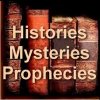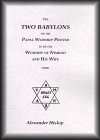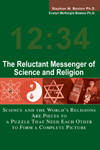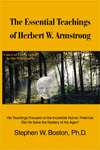
Introduction
Preface Second Ed.
Preface Third Ed.
Note by the Editor
The Two Systems
Trinity in Unity
Mother and Child
The Child in Assyria
The Child in Egypt
The Child in Greece
Death of the Child
Deification of the Child
Mother of the Child
Christmas
Easter
Nativity of John
Feast of thr Assumption
Baptismal Regeneration
Justification by Works
Sacrifice of the Mass
Extreme Unction
Purgatory and Prayers for the Dead.
Idol Processions
Relic Worship.
Clothing and Crowning of Images.
The Rosary
Lamps & Wax-candles
Sign of the Cross
Sovereign Pontiff
Priests, Monks, and Nuns.
Great Red Dragon
Beast From the Sea
Beast from the Earth
Image of the Beast
Number of the Beast
Invisible Head of the Papacy
Woman with Golden Cup
Hebrew Chronology
Shing Moo and Ma Tsoopo of China.
Ala-Mahozim
Meaning of the name Centaurus
Olenos, the Sin-Bearer
Identification of Rhea or Cybele and Venus
Virgin Mother of Paganism
Goddess Mother as a Habitation.
Meaning of the name Astarte.
Oannes and Souro
The Identity of the Scandinavian Odin and Adon of Babylon
Stripping of the Clothes of the Initiated in the Mysteries
Zoroaster, the Head of the Fire-Worshippers
Story of Phaethon
Roman Imperial Standard of the Dragon of Symbol of Fire-worship
The Slaying of the Witness
Attes, the Sinner
Click here for The Reluctant Messenger (Host Site)
APPENDIX - Shing Moo and Ma Tsoopo of China.
NOTE C, p. 21. Shing Moo and Ma Tsoopo of China.
The name of Shing Moo, applied by the Chinese to their "Holy Mother," compared with another name of the same goddess in another province of China, strongly favours the conclusion that Shing Moo is just a synonym for one of the well-known names of the goddess-mother of Babylon. Gillespie (in his Land of Sinim, p. 64) states that the Chinese goddess-mother, or "Queen of Heaven," in the province of Fuh-kien, is worshipped by seafaring people under the name of Ma Tsoopo. Now, "Ama Tzupah" signifies the "Gazing Mother;" and there is much reason to believe that Shing Moo signifies the same; for Mu was one of the forms in which Mut or Maut, the name of the great mother, appeared in Egypt (BUNSEN'S Vocabulary, vol. i. p. 471); and Shngh, in Chaldee, signifies "to look" or "gaze." The Egyptian Mu or Maut was symbolised either by a vulture, or an eye surrounded by a vulture's wings (WILKINSON, vol. v. p. 203.) The symbolic meaning of the vulture may be learned from the Scriptural expression: "There is a path which no fowl knoweth, and which the vulture's eye hath not seen" (Job xxviii.7). The vulture was noted for its sharp sight, and hence, the eye surrounded by the vulture's wings showed that, for some reason or other, the great mother of the gods in Egypt had been known as "The gazer." But the idea contained in the Egyptian symbol had evidently been borrowed from Chaldea; for Rheia, one of the most noted names of the Babylonian mother of the gods, is just the Chaldee form of the Hebrew Rhaah, which signifies at once "a gazing woman" and a "vulture." The Hebrew Rhaah itself is also, according to a dialectical variation, legitimately pronounced Rheah; and hence the name of the great goddess-mother of Assyria was sometimes Rhea, and sometimes Rheia. In Greece, the same idea was evidently attached to the Mother of the children of the sun (see ante, p. 20, Note), For one of her distinguishing titles was Ophthalmitis (SMITH'S Classical Dictionary, "Athena," p. 101), thereby pointing her out as the goddess of "the eye." It was no doubt to indicate the same thing that, as the Egyptian Maut wore a vulture on her head, so the Athenian Minerva was represented as wearing a helmet with two eyes, or eye-holes, in the front of the helmet.--(VAUX'S Antiquities, p. 186.)
Having thus traced the gazing mother over the earth, is it asked, What can have given origin to such a name as applied to the mother of the gods?
A fragment of Sanchuniathon (pp. 16-19), in regard to the Phenician mythology, furnishes us with a satisfactory reply. There it is said that Rheia conceived by Kronos, who was her own brother, and yet was known as the father of the gods, and in consequence brought forth a son who was called Muth, that is, as Philo-Byblius correctly interprets the word, "Death." As Sanchuniathon expressly distinguishes this "father of the gods" from "Hypsistos," The Most High, * we naturally recall what Hesiod says in regard to his Kronos, the father of the gods, who, for a certain wicked deed, was called Titan, and cast down to hell.--(Theogonia, 1. 207, p. 18.) The Kronos to whom Hesiod refers is evidently at bottom a different Kronos from the human father of the gods, or Nimrod, whose history occupies so large a place in this work. He is plainly none other than Satan himself; the name Titan, or Teitan, as it is sometimes given, being, as we have elsewhere concluded (pp. 275, 276), only the Chaldee form of Sheitan, the common name of the grand Adversary among the Arabs, in the very region where the Chaldean Mysteries were originally concocted,--that Adversary who was ultimately the real father of all the Pagan gods,--and who (to make the title of Kronos, "the Horned One," appropriate to him also) was symbolised by the Kerastes, or Horned serpent. All "the brethren" of this father of the gods, who were implicated in his rebellion against his own father the "God of Heaven," were equally called by the "reproachful" name "Titans"; but, inasmuch as he was the ringleader in the rebellion, he was, of course, Titan by way of eminence. In this rebellion of Titan, the goddess of the earth was concerned, and the result was that (removing the figure under which Hesiod has hid the fact) it became naturally impossible that the God of Heaven should have children upon earth--a plain allusion to the Fall.
Now, assuming that this is the "Father of the gods," by whom Rhea, whose common title is that of the Mother of the gods, and who is also identified with Ge, or the Earth-goddess, had the child called Muth, or Death, who could this "Mother of the gods" be, but just our Mother Eve? And the name Rhea, or "The Gazer," bestowed on her, is wondrously significant. It was as "the gazer" that the mother of mankind conceived by Satan, and brought forth that deadly birth, under which the world has hitherto groaned. It was through her eyes that the fatal connection was first formed between her and the grand Adversary, under the form of a serpent, whose name, Nahash, or Nachash, as it stands in the Hebrew of the Old Testament, also signifies "to view attentively," or "to gaze." (Gen. iii. 6) "And when the woman saw that the tree was good for food, and pleasant to the eyes," etc., "she took of the fruit thereof, and did eat; and gave also unto her husband with her, and he did eat." Here, then, we have the pedigree of sin and death; "Lust, when it had conceived, brought forth sin; and sin, when it was finished, brought forth death" (James i. 15). Though Muth, or Death, was the son of Rhea, this progeny of hers came to be regarded, not as Death in the abstract, but as the god of death; therefore, says Philo-Byblius, Muth was interpreted not only as death, but as Pluto.--(SANCHUN., p. 24.) In the Roman mythology, Pluto was regarded as on a level, for honour, with Jupiter (OVID, Fasti, lib. vii. 578): and in Egypt, we have evidence that Osiris, "the seed of the woman," was the "Lord of heaven," and king of hell, or "Pluto" (WILKINSON, vol. iv. p. 63; BUNSEN, vol. i. pp. 431,432); and it can be shown by a large induction of particulars (and the reader has somewhat of the evidence presented in this volume), that he was none other than the Devil himself, supposed to have become incarnate; who, though through the first transgression, and his connection with the woman, he had brought sin and death into the world, had, nevertheless, by means of them, brought innumerable benefits to mankind. As the name Pluto has the very same meaning as Saturn, "The hidden one," so, whatever other aspect this name had, as applied to the father of the gods, it is to Satan, the Hidden Lord of hell, ultimately that all came at last to be traced back, for the different myths about Saturn, when carefully examined, show that he was at once the Devil, the father of all sin and idolatry, who hid himself under the disguise of the serpent,--and Adam, who hid himself among the trees of the garden,--and Noah, who lay hid for a whole year in the ark,--and Nimrod, who was hid in the secrecy of the Babylonian Mysteries. It was to glorify Nimrod that the whole Chaldean system of iniquity was formed. He was known as Nin, "the son," and his wife as Rhea, who was called Ammas, "The Mother." The name Rhea, as applied to Semiramis, had another meaning from what it had when applied to her, who was really the primeval goddess, the "mother of gods and men.'" But yet, to make out the full majesty of her character, it was necessary that she should be identified with that primeval goddess; and, therefore, although the son she bore in her arms was represented as he who was born to destroy death, yet she was often represented with the very symbols of her who brought death into the world. And so was it also in the different countries where the Babylonian system spread.
Previous | Next

or The Papal Worship Proved to be the Worship of Nimrod and His Wife
$3.99 Kindle eBook
Buy from Amazon.com
The Essential Teachings of Herbert W. Armstrong
His Teachings Focused on The Incredible Human Potential. Did He Solve the Mystery of the Ages?
New Book about HWA's Teachings. Recommended!

